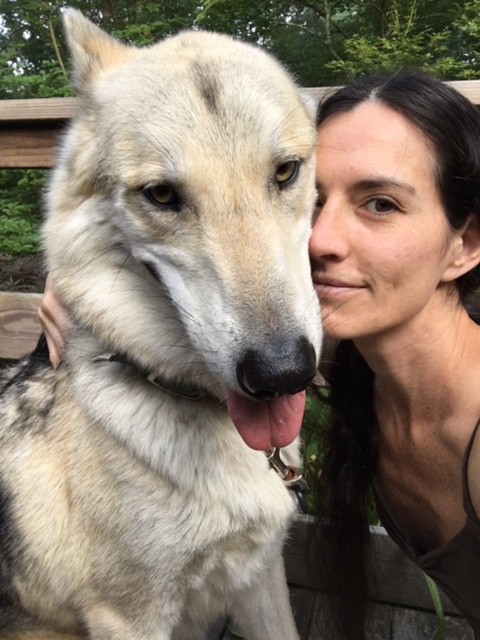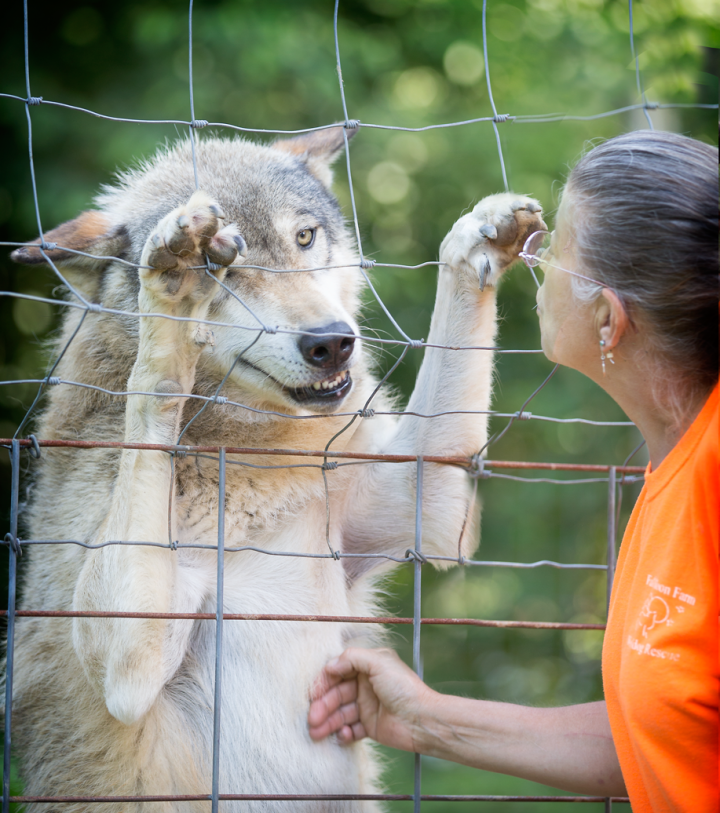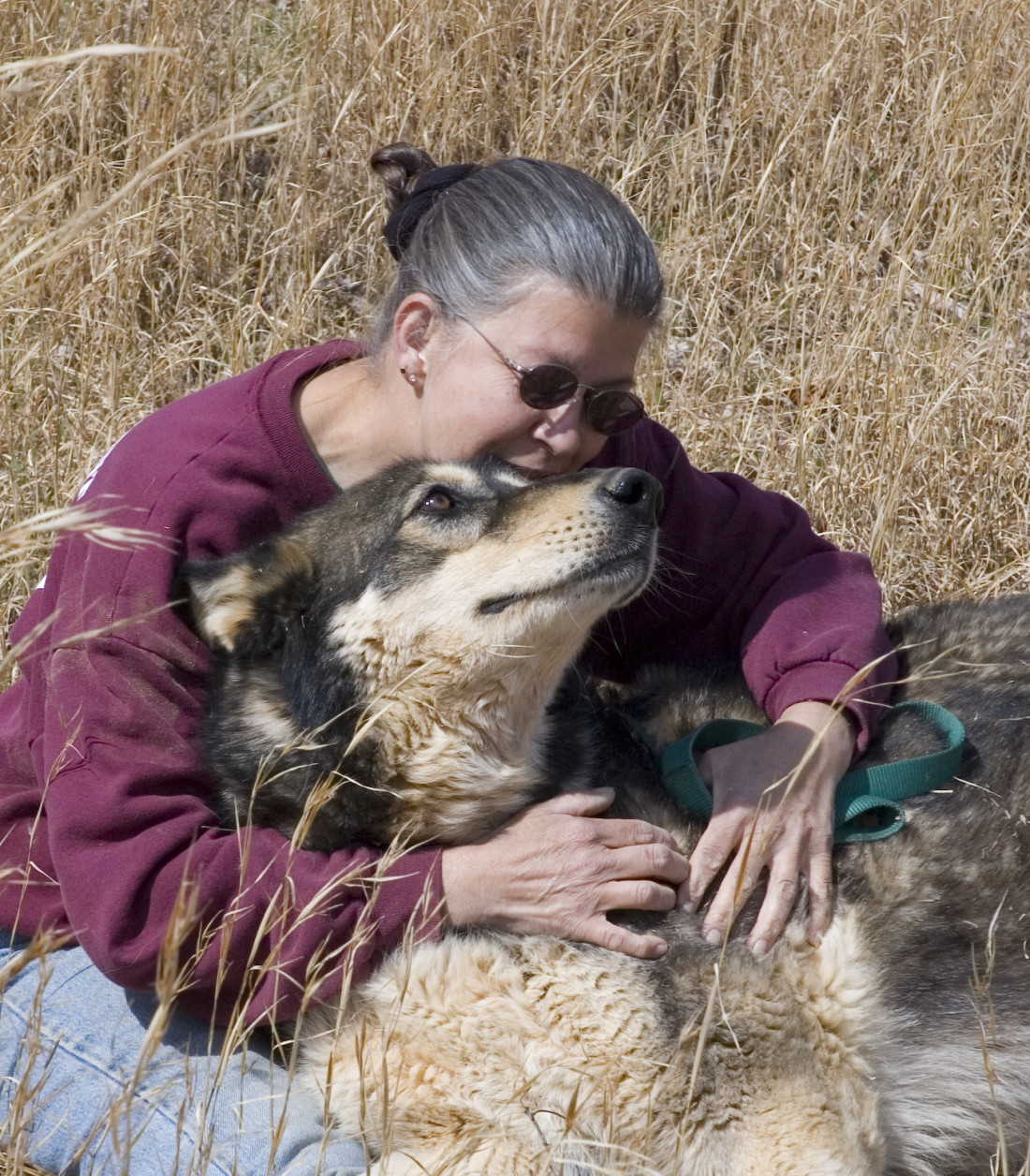In 1994, Nancy Brown acquired her first wolfdog, a canine mix of dog and wolf, typically “three or more generations removed from pure wolves,” she says. A gift from her now-ex-husband, that wolfdog ignited a passion and, ever since, Brown has been on a mission to educate the public about wolves and save their canine relatives, wolfdogs. Along the way, Brown founded Full Moon Farm Wolfdog Sanctuary in Black Mountain. Now 14 years old, the sanctuary is one of only two facilities in the country dedicated exclusively to rescuing the canines. Its rescue efforts have helped improve the health and wellness of wolfdogs, many of whom have been abused, neglected or killed.
One of the biggest misconceptions about these canines is that they are half-wolf, half-dog, says Brown. “Eighty-five percent of [them] are products of wolfdog-to-wolfdog breeding or wolfdog-to-dog breeding,” she says. The canines are “capable of being good companion pets and animals,” but because of their intelligence, athletic prowess and appearance of being wolves, they tend to be more in danger from humans than vice versa, says Brown.
Most of the wolfdogs at Full Moon Farm have “lived their lives on chains, were bought as a status symbol [by owners who did not know how to care for them], picked up running as a stray with no known background, or bought to breed and never given any social skills,” says Brown. Most of them do not make good “add-collar instant pets,” she says.
Fortunately there are some exceptions.
“[My wolfdog] is good; he stays off the furniture and the kitchen counter,” says Kamala Beissinger, a Full Moon Farm volunteer who has a lifetime foster agreement to care for her 90-pound, white-and-gray wolfdog, Lakota. She says “the kitchen counter” as if it’s normal to have to train your dog to keep off the counters. Because of their size and athleticism, wolfdogs can easily leap to counters.

Beissinger grew up with German shepherds and says that caring for Lakota, who has some shepherd in him, is not that different from owning and training a shepherd. “Wolfdogs are just as intelligent if not more [than German shepherds]; you just run into more necessary containment issues, like [needing] higher fences because they are more athletic animals and have a slightly higher need for exercise and consistency in rules and regulations. They are problem solvers and are not used to asking humans for help, so they can figure out how to open the refrigerator if they want to,” she says.
The key to being a responsible wolfdog owner is “being more intelligent than the canine,” Brown says. “What kind of car do you drive? Some people drive Corvettes. Wolfdogs are your high-performance canine. … They’re problem-solving, intelligent, opportunistic beings,” she says.
Breeders sell wolfdogs for $1,500 to $7,500, according to Brown. But owners often do not understand how to manage a highly intelligent animal or how to handle the strong prey-or-play drive that some wolfdogs exhibit. “If it moves fast and it squeaks, it’s a toy, whether it’s a cat, Jack Russell terrier or a stuffed animal,” says Brown.
Huskies, Malamutes, and German shepherds — the three breeds most often found in wolfdogs — can exhibit the same behaviors, she says. In fact, most wolfdogs will have all four breeds in their DNA: “You’re going to have a little wolf, a little husky, a little Malamute, a little German shepherd. There are not half-and-half animals being bred. All the animals on my place right now are mutts, a mixture of many breeds,” she says.
Although wolves and dogs are classified as different species, “just the simple fact that wolves and dogs can interbreed tells us they are very similar genetically, says Scott Pearson, professor of biology at Mars Hill University. The latest scientific findings show that the domesticated dog has been in existence for 18,000 to 32,000 years and, therefore, has had a lot of time to evolve into the modern dogs we know today, he says.
Dogs have evolved to be a lot like wolf cubs, says Pearson, a wildlife biologist. “If you compare an adult wolf’s head and face to an average dog, the dog looks more similar to the wolf cub than it does to the adult wolf,” he says. Basically “the behavioral traits that make dogs great with people, and wolves not that great with people, are traits that tend to be found in the wolf cubs,” he says.
To explain how evolutionary biology works, Pearson suggests considering how a set of ingredients for something like bread are combined in slightly differently ways: “In one combination you get cookies; in another you get fruitcake [or] carrot cake [or] maybe a biscuit, either by adding an ingredient in or leaving it out, or by adjusting the ratio of ingredients,” he says. “Organisms are the same way. So you can have one set of genes that have all the various steps for building either a hyena, a fox, a wolf, a domestic dog. The difference between producing a hyena or a domestic dog is when specific steps are turned on and turned off,” says Pearson.
The domestication of the dog is “really just evolution because all we’re doing is changing the activity of the original wolf genes still found in today’s dogs,” he says.
Despite the thousands of years of evolution separating dogs and wolves, says Brown, “There is no behavior a dog can do that wolf won’t or vice versa. The major difference between wolfdogs and dogs is the intensity,” says Brown. For example, wolfdogs “amp up very fast. If you’re walking up to an enclosure where the dog dislikes you, [you see] that hair going up, the ears are going forward, the tail is sticking out,” says Brown.
“Scientifically it’s called ‘dumbed down.’ Dogs are dumbed down, childlike in their behaviors. They are bred to serve, so they’re like children,” says Brown. “Wolfdogs, on the other hand, are more true to primitive nature. Wolfdogs with low wolf content can be more childlike, a mid-content [wolfdog] is going to be like a teenager (they’re going to be a smart-ass, they’re going to test you), and a high-content or pure wolf is going to be like a 40-year-old man — you aren’t going to make him do anything; it’s going to be ‘what’s in it for me.’ Reward-based treats works best,” she says.
Despite their intelligence and physical prowess, Brown stresses that wolves and wolfdogs are in much greater danger from humans than vice versa. “Little Red Riding Hood lied. The big bad wolf is a myth. People fear what they don’t understand. If they fear, they kill,” says Brown. Misunderstanding about wolves goes back to Pope Constantine, who in 1514 branded the wolf the “devil’s dog” and said it should be eradicated, she says. “That is centuries of mythology that we’re trying to undo,” says Brown.
Wolfdogs with higher wolf content are more timid than their low-content counterparts, she adds; people think they’d make good watchdogs, but they are more likely to cower under a table than confront the stranger. This is because wolfdogs and wolves care more about self-preservation, says Beissinger. “Their propensity to run and hide far outweighs any possibility of attack or defense.”

The farm keeps its wolfdogs behind 8 1/2-foot-high fences “not because my animals are dangerous, but people are,” Brown explains. “They want to shoot anything they don’t understand or fear. I want to make sure my animals are safely contained. … There was an animal killed a few months back over in South Carolina. A guy thought it was a coyote, [but] it was a well over 100-pound, black-faced British Columbian wolfdog. I know the breeder of the animal, and I have one here that looks just like it. Here this guy was shooting somebody’s pet,” says Brown. For this reason she is passionate about public education.
Beissinger says her wolfdog, Lakota, is very socialized and will likely be serving as an ambassador for the farm. Lakota is a mid-content wolfdog, based on different physical characteristics, such as his yellow eyes, a straight, black-tipped, bottle-brush tail and certain behavioral characteristics. To keep Lakota socialized, Beissinger takes him on walks twice a day, brings him out into public at least three times a week and goes hiking with him where there are lots of people and dogs.
“I make him deal with everything frequently. And he rides in the car wonderfully. If I leave him in the car, he does eat my seat belt,” she says, laughing. She believes the reason is that he associates her taking off her seat belt with the car door opening, so he pulls on it and thereby eats through it. “He see the chain of events — I take off my seat belt and then the door opens. He can’t see my hand do the handle, thank goodness.”
Currently Brown has around 55 wolfdogs at the farm. “People ask, ‘Do they howl more on the full moon?’ Well, of course. It’s bright outside; they can see the wildlife moving,” says Brown. Her neighbors have wolfdogs as well, and on some nights she says it’s like the whole mountain is singing.
More Info
Nancy Brown, Full Moon Farm
fullmoonfarm.org
Public Event: Howl for the Holidays, Full Moon Farm, Saturday, Nov. 19, 1-5 p.m.
Scott Pearson, Mars Hill University
spearson@mhu.edu




Thanks Nicki! One clarification – Black PHASE British Columbian. :-)
thank you Nancy!
thanks Nancy!
Are domestic dogs and gray wolves the same species? According to the “biological species concept”, they *are* the same species because they can interbreed and produce reproductively viable offspring (i.e., wolfdogs). In contrast , the “ecological species concept” would suggest they are *different* species because dogs and wolves are adapted to different ways of making a living (i.e., different ecological niches). The niche of dogs involves living in partnership with humans. Different species concepts have been proposed in biology; there are others beyond these two. No single species concept is perfect in all situations, so different concepts are employed to fit the characteristics of species under consideration and the scientific questions being asked. Thus, the answer to the question above is “yes” or “no” depending on one’s definition of a “species”.
Thanks for expanding and clarifying on that point Scott!
Well written interesting informative article….a subject I knew nothing about.